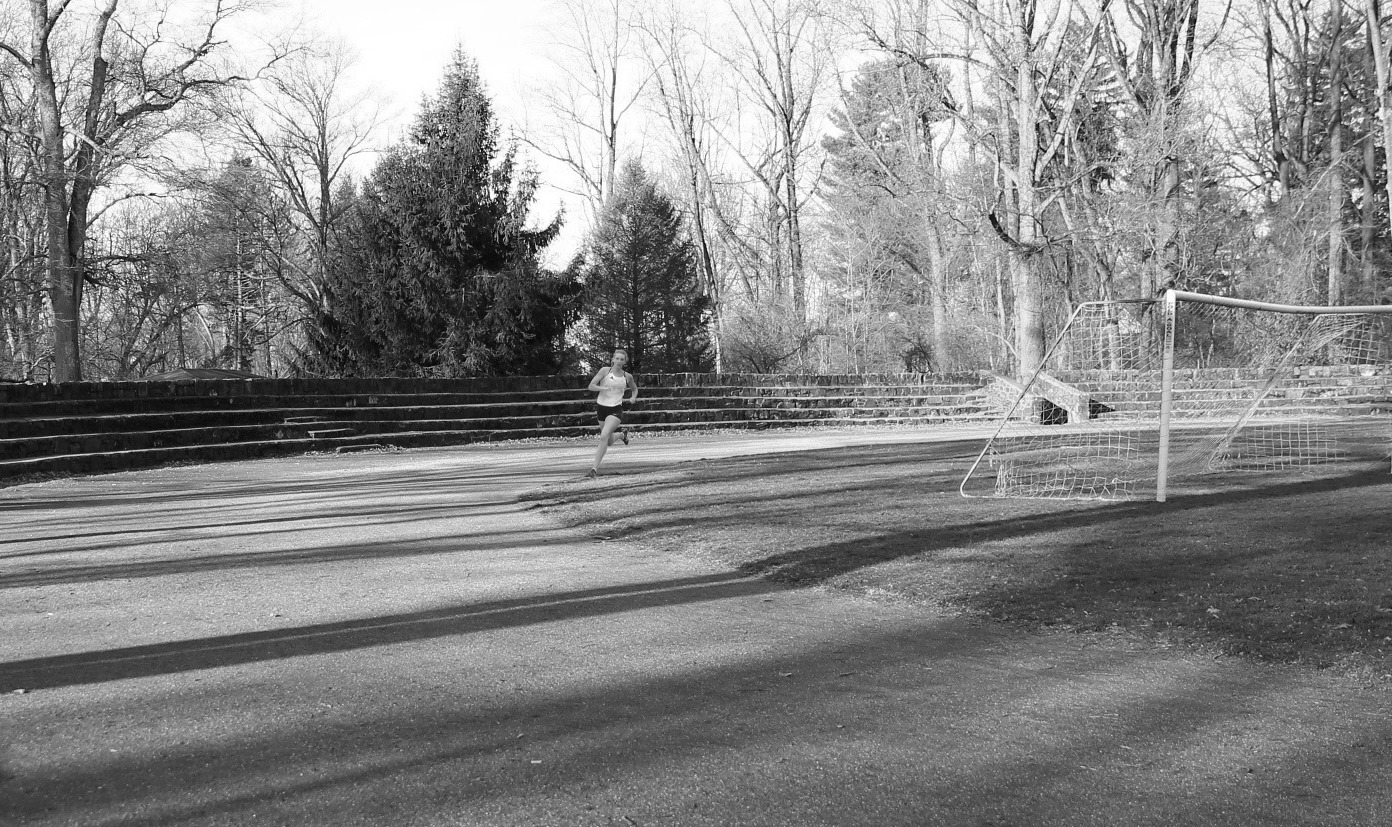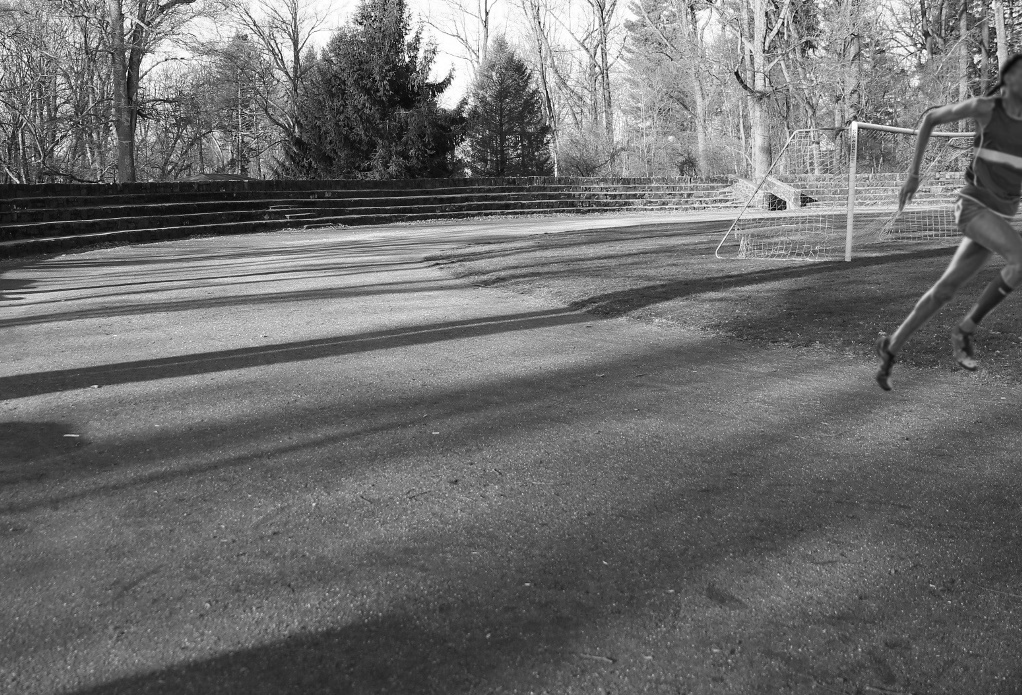Secrets from the Cinders: An 800m Dream Showdown Comes to Life
How A Positive Plan Yielded A Powerful Result In Lieu oF Other Options Less Safe
“So are these … cinders?”
 The long-limbed East Coast runner had squatted down to scoop up and examine a handful of what made up the surface of this track, which seemed like it belonged on another planet.
The long-limbed East Coast runner had squatted down to scoop up and examine a handful of what made up the surface of this track, which seemed like it belonged on another planet.
“They sure are,” said her old coach. He had run on some cinder tracks in his day.
The East Coast runner glanced around at the other two runners with whom she was soon to race, each having marked her territory on other sections of the oval. They were also examining a track the likes of which they had never seen.
“You might think that you can’t run fast on cinders,” said the old coach, “but a good cinder track is fast. And this isn’t bad, given that it probably hasn’t been used in years.
“And hey, the weather we’ve had lately, the track isn’t too dry or too wet. So yeah, it should be fast!”
The bigger question was why three of the best prep 800m runners in the country would be preparing to race on this track from the past, surrounded by woods in the middle of nowhere? It was crazy, but it was the only way they might ever race each other – three girls who were among the best seven ever to run the distance.
 Indoor nationals had been cancelled a few weeks earlier … and the girls’ 800m was the most highly anticipated showdown of the meet. The East Coast runner in particular was longing for it, perhaps more than any of the other girls, and more than any of the track geeks who would have filled the championship facility or sat transfixed to their computers and phones to watch it.
Indoor nationals had been cancelled a few weeks earlier … and the girls’ 800m was the most highly anticipated showdown of the meet. The East Coast runner in particular was longing for it, perhaps more than any of the other girls, and more than any of the track geeks who would have filled the championship facility or sat transfixed to their computers and phones to watch it.
She was beaten in last year’s edition of the race, a shocking upset after a season of unparalleled success. This winter she and her coach had kept racing to a minimum and focused on shorter distances. In fact, she was originally slated to run one of those shorter races at nationals. But then came the incredible day in early March when three other girls all ran 2:03 on the same day – in two separate meets – and so the East Coast runner was compelled to step up for the challenge.
She was a senior. This was it. She had to do it.
Now it was the morning of April 1st and two of those three other 2:03 girls were warming up about 100 meters away, stretching and jogging in opposite directions away from her – a sophomore from the Mid-Atlantic region and a freshman from New England. They were going to race after all, even if it was more than two weeks after nationals and on an old cinder track.
But where were they? Where was this track, anyway? None of them knew.
Two old meet directors stood by the edge of the woods, watching this scene from the backstretch outside the track. They knew where they were … and the fact that no one else would know this location was part of the conditions for staging the race. They knew that gatherings of any kind were forbidden during COVID-19, so in an oversized bus they picked up each of the three girls and their coaches at a well-known meeting spot in a centralized big city location – relatively equal distance from each of their hometowns. Social distancing and wipe downs ensued and they boarded quietly and discreetly.
The windows of the bus, save for the windshield, were darkened. So during the hour-plus drive, none of the passengers knew where they were going. When they finally exited the bus, all that was apparent was that they were at an old track, surrounded by a heavily wooded area, in some kind of a park. They didn’t even know what state they were in.
So as the East Coast runner continued to warm up, anxious thoughts raced through her mind. It had actually been four girls and their coaches that had been invited to the clandestine event, but last year’s national champion – a runner from the Midwest – had contacted the directors two days before the event to say she couldn’t make it.
 It shouldn’t have been a surprise; she would have had to travel much further than the others. But it was still an agonizing blow for the East Coast runner, who was the victim of the Midwest runner’s kick last year. That was one of the biggest reasons she had switched to the 800 for nationals, to get another chance to race her nemesis. It was the biggest reason why she was here at this crazy track.
It shouldn’t have been a surprise; she would have had to travel much further than the others. But it was still an agonizing blow for the East Coast runner, who was the victim of the Midwest runner’s kick last year. That was one of the biggest reasons she had switched to the 800 for nationals, to get another chance to race her nemesis. It was the biggest reason why she was here at this crazy track.
And what kind of a competition was this, anyway? Thanks to social distancing, the three of them could not physically race next to each other, so a most unusual setup was devised. Each runner would start separately at the normal start line, the 100m mark, and the 300m mark, respectively. Each would complete two full laps and the one to do so the fastest would win.
The old meet directors had enlisted the assistance of a most enterprising professional timer. He had set up finish cameras at each 100m mark (he hadn’t gotten the memo that the fourth runner wasn’t coming), with everything linked together, so each girl could be timed from their separate start and finish points.
Thus, the starting gun would go off, with the East Coast runner starting and finishing from the normal start/finish line, the New England runner going off from the 100m mark, and the Mid-Atlantic runner taking off from the 300m mark. The sight of these three ripping up the cinders at close to 2:00 800m pace from three separate spots would be most unusual.
Then they saw the other girl.
A fourth runner had emerged from the woods next to the backstretch of the track, looking around, and then staring at the race directors about 30 meters away. Finally, she waved to them; then she and a man whom they would learn was her father started walking toward them.
They stopped about 20 feet away from the meet directors and stood facing them. “We’re wondering if she can race, too,” the father finally said. He seemed to instantly understand the setup. “She could start here on the backstretch at the 200m mark. My daughter and I live nearby, where we homeschool her, and we heard about this. She hasn’t run an 800 before, but she’s really fast at 400 and has good endurance, too.”
“But … how … how did you know about this? No one else is supposed to know. We haven’t publicized this at all.”
The father started to answer, but his daughter jumped in. “PLEASE! Oh, please let me race!” She pleaded and begged and the meet directors looked at each other. The gun was supposed to go off in less than five minutes but, being two good-hearted men, they couldn’t say no and didn’t want to deal with any additional drama.
 So they said she could race and then they turned and informed the others regarding the new, fourth competitor. The East Coast runner was in such a zone that she barely heard what they said. She was ready to race better than she ever had before, and nothing was going to stop her.
So they said she could race and then they turned and informed the others regarding the new, fourth competitor. The East Coast runner was in such a zone that she barely heard what they said. She was ready to race better than she ever had before, and nothing was going to stop her.
Three minutes later, the older meet director fired the starting gun and the four runners were off.
As a unique pacing aid, the race directors had procured a bell, the kind that is rung for the final lap in a big meet. They planned to ring this bell every 30 seconds so the runners could know how close they were to 2:00 pace each time they completed a half-lap – and maybe one or more of them would reach or exceed that goal.
Indeed, good pacing was heavy on the mind of the East Coast runner. She hadn’t had anything left during the final 100 meters of last year’s championship … and hadn’t she been racing the shorter distances all winter long to improve her speed? So she went out steady but conservatively – and itching to pick up the pace with each segment.
Meanwhile, the Mid-Atlantic runner had started more quickly, hammering the cinders with her powerful stride. She had passed her own 200m mark just before the first bell and showed no signs of letting up. The New England runner was moving fast herself with a sleek, smooth form, looking almost effortless. But she had not quite reached her 200m post when she heard the bell, so she picked it up slightly.
No one had started faster than the local girl, however. Her style was unrefined, fast but flailing. As with some sprinters who move up in distance, she was starting too fast and appeared to pass her mark in just under 29 seconds.
“She’s probably going to start rigging by 600,” said one of the meet directors to the other.
Each of the three original runners appeared to be around 60 seconds at the end of their respective opening laps. The meet directors looked at each other with knowing grins. It was on!
The East Coast runner, however, actually heard the 60-second bell just before she finished her lap … and she felt a bit of relief washing over her. She should have plenty left on this final circuit, and she wanted the final 200 to be the best of her career. It would be untrue to say she had prepared for this all winter, since she was originally entered in a different event for nationals. But the year-long plan was to be in the best 800 shape of her life by summer and possess a lethal kick like never before. She sensed she might be able to unleash such a finish today.
Meanwhile, the local girl had again passed her checkpoint before anyone else, likely just under 59 for the lap, but her form was getting worse and she was grimacing in pain. She wouldn’t get passed, that was for sure, but she would probably finish well after the others.
 At 600m, the Mid-Atlantic runner was just two strides behind the bell, and the New England runner perhaps four strides off. Both started digging deep, however, and soon began to sprint with authority.
At 600m, the Mid-Atlantic runner was just two strides behind the bell, and the New England runner perhaps four strides off. Both started digging deep, however, and soon began to sprint with authority.
The East Coast runner passed her mark right at the bell – 1:30 for 600m – and, for a few brief moments, felt pangs of doubt and fatigue. No, she said to herself, I will not break down. She looked up and started working her arms and legs harder. She felt the cool breeze on her face and summoned up the emotion from her greatest triumphs.
Each of the original trio ran spectacularly in the final 100. The meet directors lost their cool and began cheering wildly. They had moved just beyond the finish line, where the bell was located, and watching all four girls at once was difficult. The men became transfixed on the East Coast runner motoring down the stretch toward the normal finish line. Indeed, this was a different girl than the one who finished second at nationals last year.
Feeling every bit of her extraordinary power, the East Coast runner crossed the finish line and thrust her arms in the air as if she knew she had won. There had been no breakdown in form and she was almost sure she had PR’d. The runners from the Mid-Atlantic and New England had crossed their respective finish lines in style as well, but appeared like they might have done so just a bit later.
Then the meet directors heard an agonized yell and their attention was redirected to the backstretch of the track. The local girl was sprawled out on the cinders past her finish line at the 200m mark, rolling over on her back in exhaustion and pain. They hadn’t seen her finish, but what do you know? It couldn’t have been long after the others, if at all.
What they didn’t see while watching the East Coast runner’s finish was the incredible way the local girl had rallied in her own final 100m – perhaps not very smoothly, but digging deep and eating up track like no one’s business. She had proven she belonged.
Moments later, everyone started to converge in the infield – while maintaining, of course, more than six feet between each of them. They met in a large circle, the two meet directors, the four athletes, the three coaches (plus a father) and the timer – who held in his hand a sheet of paper which contained what everyone wanted to know. He had read the photos from each finish line, written down the times, and left his timing tent from the opposite side of the track.
He handed the results to the younger of the two meet directors, who had intended to read off the results in order from fourth to first. But when he saw the times, those plans were blown away.
“ONE FIFTY NINE!!” he shouted, “1:59.85!!” He looked at the East Coast runner. “YOU DID IT!! You broke two minutes!!!”
The East Coast runner screamed with joy, pumped her fist and leapt into the air. She gave her old coach a big hug.
The Mid-Atlantic and New England girls had PR’d as well, running 2:01.99 and 2:02.23. They also hugged their coaches, but of course did not hug each other or anyone else.
“Hey, did you get my time too?”
All turned to the local girl, whose knees and arms were a bit scraped up and covered in cinders. “Oh geez, I’m sorry,” the timer yelped. He turned and raced back to his tent. Forty five seconds later, he was back and handed another slip of paper to the meet director who had read the original results.
He looked at the slip of paper and his eyes grew wide. “Two-flat, point-five,” he read, unmistakable amazement in his voice. “Your first-ever 800 … and you ran 2:00.50!”
The meet directors basically expected the local girl to collapse again with that news, this time in freaked-out joy and amazement in what she had done. But instead, she just smiled, gave a little thumbs up, and high-fived her dad. “I knew you could do it,” they heard him say.
There was nothing left to do except a quick warmdown and back to the bus, ready to take the long trip back to the original meeting point. The longer the group was at the track, the greater the danger of being caught, or so it seemed.
The meet directors realized, to their disbelief, that they had never gotten the local girl’s name. They hurried back to the backstretch and the path into the woods there, from where she and her father had come.
But they were gone.
“Darn!” said the younger of the two men. “Not only can I not believe what we just saw, but we just watched a girl we’d never seen before run 2-flat and we don’t even know her name!”
“Yeah … but think of it this way,” said the other, turning to his old friend with a wry grin. “If we can get rid of this dang coronavirus, think what a great outdoor meet we’re gonna have!”
___
Thanks to John Nepolitan for his outstanding photos and to JT Nelson for his excellent editing.




